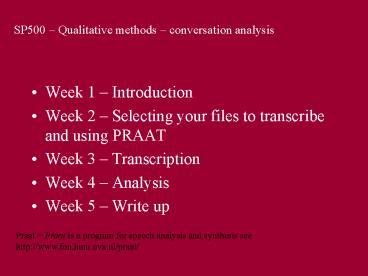SP500 Qualitative methods conversation analysis - PowerPoint PPT Presentation
1 / 9
Title:
SP500 Qualitative methods conversation analysis
Description:
Week 2 Selecting your files to transcribe and getting used to using PRAAT ... by slight gap or slight overlap, they make up the vast majority of transitions. ... – PowerPoint PPT presentation
Number of Views:112
Avg rating:3.0/5.0
Title: SP500 Qualitative methods conversation analysis
1
SP500 Qualitative methods conversation
analysis
- Week 1 Introduction
- Week 2 Selecting your files to transcribe and
using PRAAT - Week 3 Transcription
- Week 4 Analysis
- Week 5 Write up
Praat Praat is a program for speech analysis
and synthesis see http//www.fon.hum.uva.nl/praat/
2
Discourse and power
- 1. Foucault (1972 1977) and discursive epistemes
(knowledge discourses) - The interdependence between discourse and power
- The relation between power and knowledge
systems of power bring forth different types of
knowledge, which in turn produces effects on
people who then reproduce the original power
relation
3
Week 2 Selecting your files to transcribe and
getting used to using PRAAT
- (a) Power and talk thinking about institutional
talk and role relationships - (b) You are comparing examples so as to uncover
any evidence that people use the structures of
talk to exert or resist specific role-relations
in context
4
- Qualitative methods conversation analysis
comparing non-institutional (informal) talk with
institutional talk - Informal talk
- (a) students talking
- (b) talk between mother and daughter
- Institutional talk
- (c) doctor-patient interaction
- (d) courtroom talk
- (e) classroom talk
- (f) police-suspect talk
- (g) radio phone-in talk
- (h) job interview
- (i) meeting
5
Turn-taking rules
- RULE 1 This rule applies to the first transition
relevant place of any turn - (a) If the current speaker selects the next
speaker during the current turn then the current
speaker must stop speaking and the next speaker
must speak next. And he/she must speak next at
the first transition relevant place after this
'next speaker' selection - (b) If the speaker does not select a next
speaker during a current turn, then anybody else
present (other parties) can self-select and the
first person to do this will gain 'speaker
rights' at the next turn. - (c) If the current speaker has not selected the
next speaker and nobody else self-selects then
the speaker can continue (although this is not a
requirement). In doing so he/she gains a right to
have a further turn-constructional unit. - RULE 2 When rule 1 (c) has been applied by the
current speaker, then at the next transition
relevant pause, rules 1 (a) to 1 (c) apply again,
and keep reapplying until speaker change is
accomplished. - The set of rules and the elements used by people
to indicate transition relevant places are
conceived of as a system - a system which is
designed to faciliate the 'turn-taking'
organisation central to conversation. - How to do conversation analysis a brief guide
6
- A turn-taking check-list (for observing and/or
analysing recorded conversation). (Adapted from
Sacks, Schlegoff and Jefferson, 1974). - 1. Speaker-change recurs, or at least occurs
- 2. Overwhelmingly, one party speaks at a time
- 3. Occurrences of more than one speaker at a
time are common, but brief - 4. Transitions (from one turn to the next) with
no gap and no overlap are common. Together with
transitions characterised by slight gap or slight
overlap, they make up the vast majority of
transitions. - 5. Turn order is not fixed, but varies
- 6. Turn size is not fixed, but varies
- 7. Length of conversation is not specified in
advance - 8. What parties say is not specified in advance
- 9. Relative distribution of turns is not
specified in advance - 10. Number of parties can vary
- 11. Talk can be continuous or discontinuous
- 12. Turn allocation techniques are obviously
mixed (see rules above). - 13. Various turn-constructional links are
employed, e.g., turn can be projected one word
long or they can be sentential in length - 14. Repair mechanisms exist for dealing with
turn-taking errors and violations, e.g., if two
parties find themselves talking at the same time,
one of them will stop prematurely, thus repairing
the trouble.
7
Guide for the practical
- http//www.kent.ac.uk/psychology/department/people
/forresterma/c8MFx.pdf
8
An example transcript
9
SP500 Qualitative methods conversation
analysis
- Week 1 Introduction
- Week 2 Selecting your files to transcribe and
using PRAAT - Week 3 Transcription
- Week 4 Analysis
- Week 5 Write up
Praat Praat is a program for speech analysis
and synthesis see http//www.fon.hum.uva.nl/praat/

